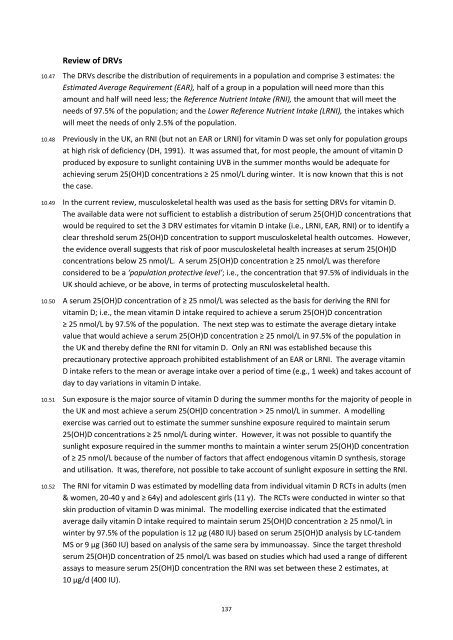Vitamin D and Health
SACN_Vitamin_D_and_Health_report
SACN_Vitamin_D_and_Health_report
Create successful ePaper yourself
Turn your PDF publications into a flip-book with our unique Google optimized e-Paper software.
Review of DRVs<br />
10.47 The DRVs describe the distribution of requirements in a population <strong>and</strong> comprise 3 estimates: the<br />
Estimated Average Requirement (EAR), half of a group in a population will need more than this<br />
amount <strong>and</strong> half will need less; the Reference Nutrient Intake (RNI), the amount that will meet the<br />
needs of 97.5% of the population; <strong>and</strong> the Lower Reference Nutrient Intake (LRNI), the intakes which<br />
will meet the needs of only 2.5% of the population.<br />
10.48 Previously in the UK, an RNI (but not an EAR or LRNI) for vitamin D was set only for population groups<br />
at high risk of deficiency (DH, 1991). It was assumed that, for most people, the amount of vitamin D<br />
produced by exposure to sunlight containing UVB in the summer months would be adequate for<br />
achieving serum 25(OH)D concentrations ≥ 25 nmol/L during winter. It is now known that this is not<br />
the case.<br />
10.49 In the current review, musculoskeletal health was used as the basis for setting DRVs for vitamin D.<br />
The available data were not sufficient to establish a distribution of serum 25(OH)D concentrations that<br />
would be required to set the 3 DRV estimates for vitamin D intake (i.e., LRNI, EAR, RNI) or to identify a<br />
clear threshold serum 25(OH)D concentration to support musculoskeletal health outcomes. However,<br />
the evidence overall suggests that risk of poor musculoskeletal health increases at serum 25(OH)D<br />
concentrations below 25 nmol/L. A serum 25(OH)D concentration ≥ 25 nmol/L was therefore<br />
considered to be a ‘population protective level’; i.e., the concentration that 97.5% of individuals in the<br />
UK should achieve, or be above, in terms of protecting musculoskeletal health.<br />
10.50 A serum 25(OH)D concentration of ≥ 25 nmol/L was selected as the basis for deriving the RNI for<br />
vitamin D; i.e., the mean vitamin D intake required to achieve a serum 25(OH)D concentration<br />
≥ 25 nmol/L by 97.5% of the population. The next step was to estimate the average dietary intake<br />
value that would achieve a serum 25(OH)D concentration ≥ 25 nmol/L in 97.5% of the population in<br />
the UK <strong>and</strong> thereby define the RNI for vitamin D. Only an RNI was established because this<br />
precautionary protective approach prohibited establishment of an EAR or LRNI. The average vitamin<br />
D intake refers to the mean or average intake over a period of time (e.g., 1 week) <strong>and</strong> takes account of<br />
day to day variations in vitamin D intake.<br />
10.51 Sun exposure is the major source of vitamin D during the summer months for the majority of people in<br />
the UK <strong>and</strong> most achieve a serum 25(OH)D concentration > 25 nmol/L in summer. A modelling<br />
exercise was carried out to estimate the summer sunshine exposure required to maintain serum<br />
25(OH)D concentrations ≥ 25 nmol/L during winter. However, it was not possible to quantify the<br />
sunlight exposure required in the summer months to maintain a winter serum 25(OH)D concentration<br />
of ≥ 25 nmol/L because of the number of factors that affect endogenous vitamin D synthesis, storage<br />
<strong>and</strong> utilisation. It was, therefore, not possible to take account of sunlight exposure in setting the RNI.<br />
10.52 The RNI for vitamin D was estimated by modelling data from individual vitamin D RCTs in adults (men<br />
& women, 20-40 y <strong>and</strong> ≥ 64y) <strong>and</strong> adolescent girls (11 y). The RCTs were conducted in winter so that<br />
skin production of vitamin D was minimal. The modelling exercise indicated that the estimated<br />
average daily vitamin D intake required to maintain serum 25(OH)D concentration ≥ 25 nmol/L in<br />
winter by 97.5% of the population is 12 µg (480 IU) based on serum 25(OH)D analysis by LC-t<strong>and</strong>em<br />
MS or 9 µg (360 IU) based on analysis of the same sera by immunoassay. Since the target threshold<br />
serum 25(OH)D concentration of 25 nmol/L was based on studies which had used a range of different<br />
assays to measure serum 25(OH)D concentration the RNI was set between these 2 estimates, at<br />
10 µg/d (400 IU).<br />
137


